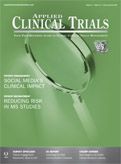Public Clinical Research Literacy: New Insights
Applied Clinical Trials
The first series of results from the Center for Information and Study on Clinical Research Participation’s (CISCRP) landmark 2017 Perceptions & Insights Study.
This article is the first in a series on the results of the Center for Information and Study on Clinical Research Participation’s (CISCRP) 2017 Perceptions & Insights Study. Nearly 12,500 people worldwide responded-including the public, patients, and study volunteers-and provided valuable insights into opportunities to improve global education, outreach, and engagement.
Awareness and education gaps
The overwhelming majority of the public recognizes the important conceptual role that clinical research plays in the discovery and development of new medicines (see chart). This result holds even for those who have never participated in a clinical trial. North Americans and Europeans self-report being the most informed, with more than eight-out-of-ten indicating that they feel “Very” or “Somewhat Informed.” People in the Asia-Pacific region report feeling the least informed (67%). Differences were also observed by age: The youngest age groups, made up of 18-34-year-olds, were more apt to report feeling less informed.

The vast majority (82%) of respondents overall believe that they understand the meaning of the term “clinical research study.” A much higher percentage of women believe that they understand the term than do men. Approximately one-in-ten North Americans report that they do not understand the term well. This compares with 24% of respondents from Africa and 33% of respondents from Asia-Pacific reporting that they do not understand the term well. Age-related differences were also observed as a significantly higher percentage (20%) of 18–34-year-olds report that they don’t understand the term at all.
But the results of the 2017 Perceptions & Insights study also reveal that the global public has a very superficial understanding about clinical research, suggesting education and outreach as areas of focus. Although a high proportion of the public say that they understand the term “Clinical Research Study,” of those who self-report being “well-informed,” two-thirds are unable to name an agency or organization that oversees clinical research safety and quality, and half (51%) say that they do not know where clinical research is conducted. Differences are observed by geographic region and age. In North America, Europe, and Asia-Pacific, 51%, 52%, and 54% of the public, respectively, say that they don’t know where clinical research is conducted. Older respondents are more apt to know where research was conducted compared to younger age groups.
Public confusion about the length of time that it takes to develop a new therapy and the proportion of drugs requiring clinical testing was also apparent. Four-out-of-ten people surveyed, for example, believe that it would take five years or less to develop a new drug or therapy.
Public trust and the perceived safety of clinical research is another critical aspect of overall clinical research literacy. A very high percentage believes that clinical trials are “Somewhat Safe” and “Very Safe,” at 69% and 21% of total respondents, respectively. In this study, only 8% of North and South Americans believe that clinical studies are “Not Very Safe” and “Not at All Safe.” This compares with 12% of the European public and 16% of the Asia-Pacific public sharing this view. Perceptions of clinical research study safety are also a function of age with a significantly higher percentage (14%) of 18–34-year-olds perceiving that studies are unsafe (“Not Very Safe” and “Not at All Safe”).
The so what
These findings highlight opportunities-target audiences and educational content-for stakeholders to strengthen clinical research literacy, familiarity, and relevance and draw the public into a closer relationship with the clinical research enterprise.
Annick Anderson, Jasmine Benger, and Nova Getz are from CISCRP Research Services.
Study methodology
The objectives of this study are to establish routine global assessments of public and patient perceptions, motivations, and experiences with clinical research participation in order to monitor trends and identify opportunities to better inform and engage the public and patients as stakeholders and partners in the clinical research enterprise.
Between May and July 2017, CISCRP conducted an online international survey. The survey instrument was based in part on questions posed in past surveys. CISCRP received input and support from pharmaceutical, biotechnology, and contract research organizations (CROs), and from investigative sites. A total of 12,427 respondents completed the survey. The online questionnaire was reviewed by an ethical review committee. CISCRP collaborated with Acurian, Clariness, CureClick, HealthUnlocked, and Quintiles to reach and engage respondents.
For more information about CISCRP’s 2017 Perceptions & Insights study and to download reports, visit www.ciscrp.org.

Improving Relationships and Diversifying the Site Selection Process
April 17th 2025In this episode of the Applied Clinical Trials Podcast, Liz Beatty, co-founder and chief strategy officer, Inato, discusses a number of topics around site engagement including community-based sites, the role of technology in improving site/sponsor relationships, how increased operational costs are impacting the industry, and more.
Reaching Diverse Patient Populations With Personalized Treatment Methods
January 20th 2025Daejin Abidoye, head of solid tumors, oncology development, AbbVie, discusses a number of topics around diversity in clinical research including industry’s greatest challenges in reaching diverse patient populations, personalized treatment methods, recruitment strategies, and more.